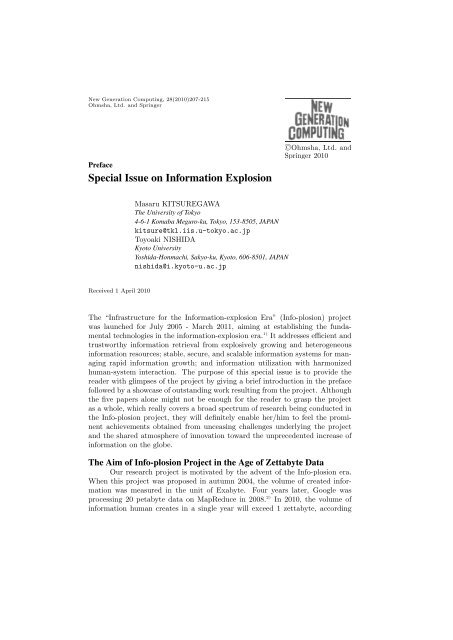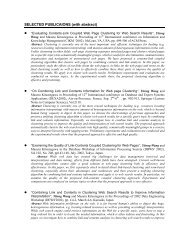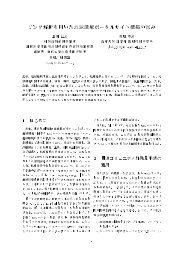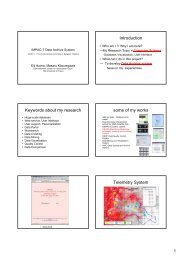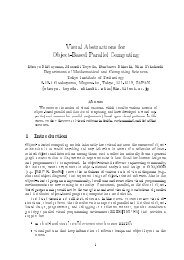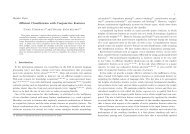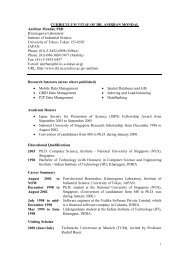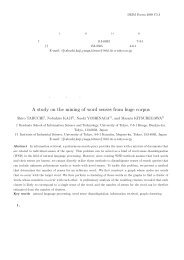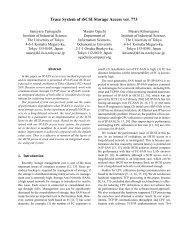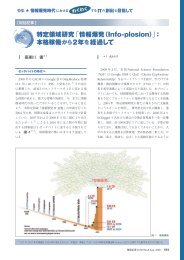Special Issue on Information Explosion
Special Issue on Information Explosion
Special Issue on Information Explosion
You also want an ePaper? Increase the reach of your titles
YUMPU automatically turns print PDFs into web optimized ePapers that Google loves.
New Generati<strong>on</strong> Computing, 28(2010)207-215<br />
Ohmsha, Ltd. and Springer<br />
Preface<br />
<str<strong>on</strong>g>Special</str<strong>on</strong>g> <str<strong>on</strong>g>Issue</str<strong>on</strong>g> <strong>on</strong> Informati<strong>on</strong> Explosi<strong>on</strong><br />
Received 1 April 2010<br />
Masaru KITSUREGAWA<br />
The University of Tokyo<br />
4-6-1 Komaba Meguro-ku, Tokyo, 153-8505, JAPAN<br />
kitsure@tkl.iis.u-tokyo.ac.jp<br />
Toyoaki NISHIDA<br />
Kyoto University<br />
Yoshida-H<strong>on</strong>machi, Sakyo-ku, Kyoto, 606-8501, JAPAN<br />
nishida@i.kyoto-u.ac.jp<br />
The “Infrastructure for the Informati<strong>on</strong>-explosi<strong>on</strong> Era” (Info-plosi<strong>on</strong>) project<br />
was launched for July 2005 - March 2011, aiming at establishing the fundamental<br />
technologies in the informati<strong>on</strong>-explosi<strong>on</strong> era. 1) It addresses efficient and<br />
trustworthy informati<strong>on</strong> retrieval from explosively growing and heterogeneous<br />
informati<strong>on</strong> resources; stable, secure, and scalable informati<strong>on</strong> systems for managing<br />
rapid informati<strong>on</strong> growth; and informati<strong>on</strong> utilizati<strong>on</strong> with harm<strong>on</strong>ized<br />
human-system interacti<strong>on</strong>. The purpose of this special issue is to provide the<br />
reader with glimpses of the project by giving a brief introducti<strong>on</strong> in the preface<br />
followed by a showcase of outstanding work resulting from the project. Although<br />
the five papers al<strong>on</strong>e might not be enough for the reader to grasp the project<br />
as a whole, which really covers a broad spectrum of research being c<strong>on</strong>ducted in<br />
the Info-plosi<strong>on</strong> project, they will definitely enable her/him to feel the prominent<br />
achievements obtained from unceasing challenges underlying the project<br />
and the shared atmosphere of innovati<strong>on</strong> toward the unprecedented increase of<br />
informati<strong>on</strong> <strong>on</strong> the globe.<br />
The Aim of Info-plosi<strong>on</strong> Project in the Age of Zettabyte Data<br />
Our research project is motivated by the advent of the Info-plosi<strong>on</strong> era.<br />
When this project was proposed in autumn 2004, the volume of created informati<strong>on</strong><br />
was measured in the unit of Exabyte. Four years later, Google was<br />
processing 20 petabyte data <strong>on</strong> MapReduce in 2008. 2) In 2010, the volume of<br />
informati<strong>on</strong> human creates in a single year will exceed 1 zettabyte, according
ngc28300 : 2010/7/14(10:21)<br />
208 M. Kitsuregawa and T. Nishida<br />
Fig. 1 Informati<strong>on</strong> Explosi<strong>on</strong>, or “Info-plosi<strong>on</strong>” 4)<br />
to IDC 3) (Fig. 1). We are in the midst of Informati<strong>on</strong> explosi<strong>on</strong> (Info-plosi<strong>on</strong>).<br />
What our project aims at is, in short, focusing <strong>on</strong> Info-plosi<strong>on</strong> as a phenomen<strong>on</strong><br />
and taking it as a new challenge for researchers in the informati<strong>on</strong> field: 1) We<br />
identify various problems that arise in the Info-plosi<strong>on</strong> era, and tackle them with<br />
pi<strong>on</strong>eer work. 2) Instead of regarding Info-plosi<strong>on</strong> as headaches, we challenge<br />
unprecedented research works in a positive attitude to create values from the<br />
explosive informati<strong>on</strong>. Generally speaking, research projects in this field usually<br />
aim at a clearly defined specific target. This project, <strong>on</strong> the other hand, has<br />
wider focus <strong>on</strong> the phenomen<strong>on</strong> of Info-plosi<strong>on</strong> as a whole. Thinking it over,<br />
it is researchers in the informati<strong>on</strong> field who gave the bases of this Info-plosi<strong>on</strong><br />
phenomen<strong>on</strong>. We are resp<strong>on</strong>sible to overcome this phenomen<strong>on</strong>.<br />
Web Search-engine Infrastructure Based <strong>on</strong> NLP In the Info-plosi<strong>on</strong> era, <strong>on</strong>e<br />
of the most serious problems is overloading of informati<strong>on</strong>. Because the volume<br />
of flooding informati<strong>on</strong> exceeds the ability of acceptance of individuals, the<br />
relative distance to reach necessary informati<strong>on</strong> becomes l<strong>on</strong>ger rather than it<br />
previously was. Therefore, a method to find exact informati<strong>on</strong> has become much<br />
more important. Although searching informati<strong>on</strong> sounds a classical topic, the<br />
situati<strong>on</strong> has been dramatically changed in the Info-plosi<strong>on</strong> era. One of the<br />
Info-plosi<strong>on</strong> we have to tackle is textual informati<strong>on</strong> <strong>on</strong> the Web. The existing<br />
search engines functi<strong>on</strong> well for a so-called navigati<strong>on</strong>al search, locating the top<br />
pages of companies, shops, and restaurants. However, they cannot support an<br />
informati<strong>on</strong>al search in a satisfactory way, such as “problems in child-rearing” in<br />
general, “a decline in the children’s physical strength,” or “measures against chil-
<str<strong>on</strong>g>Special</str<strong>on</strong>g> <str<strong>on</strong>g>Issue</str<strong>on</strong>g> <strong>on</strong> Informati<strong>on</strong> Explosi<strong>on</strong> 209<br />
Fig. 2 An Open Search-engine Infrastructure: TSUBAKI 5)<br />
dren’s physical strength decline.” We need much more powerful, next-generati<strong>on</strong><br />
search facilities to exploit the accumulated informati<strong>on</strong> <strong>on</strong> the Web. Our Infoplosi<strong>on</strong><br />
Project puts stress <strong>on</strong> research infrastructures, and has c<strong>on</strong>structed an<br />
open search-engine infrastructure, called TSUBAKI developed by Kurohashi and<br />
Shinzato (Kyoto University), for next-generati<strong>on</strong> search technologies based <strong>on</strong><br />
deep natural language processing (NLP). 5) TSUBAKI is equipped with 100 milli<strong>on</strong><br />
Japanese Web pages, cleaned up and marked up with sentence boundaries<br />
for each page, and preprocessed with the morphological analyses, syntactic analyses<br />
and syn<strong>on</strong>ymous expressi<strong>on</strong> analyses for sentences. The resultant enriched<br />
data is stored in an XML-based format. In additi<strong>on</strong> to words, syn<strong>on</strong>ymous expressi<strong>on</strong>s<br />
and dependency relati<strong>on</strong>s are registered in the index, which enables<br />
TSUBAKI to handle complex natural language expressi<strong>on</strong>s in queries and documents<br />
and to identify syn<strong>on</strong>ymous expressi<strong>on</strong>s (Fig. 2).<br />
TSUBAKI is not <strong>on</strong>ly used through ordinary Web browsers, but it also<br />
provides an open access to its Web corpus and search APIs. A large text corpus<br />
is essential to knowledge extracti<strong>on</strong> and enhancement of NLP, and the XMLbased<br />
100-milli<strong>on</strong>-page corpus has been widely used in the research community.<br />
Furthermore, white-boxed TSUBAKI APIs are supporting the next-generati<strong>on</strong><br />
search research activities, such as clustering-based Web informati<strong>on</strong> summarizati<strong>on</strong>,<br />
or opini<strong>on</strong> and sentiment overview.
210 M. Kitsuregawa and T. Nishida<br />
Innovative Search Technologies As Web is expected to be a huge library which<br />
collects human knowledge, users expect more c<strong>on</strong>venience of search. This requires<br />
thorough localizati<strong>on</strong> for each language, as TSUBAKI has realized, which<br />
is c<strong>on</strong>sidered to be a weak point of existing commercial search engines developed<br />
in the United States. As advanced search technologies, in additi<strong>on</strong> to<br />
search under complex c<strong>on</strong>diti<strong>on</strong>s, another difficult problem to solve <strong>on</strong> the Web<br />
is to grasp different opini<strong>on</strong>s. Generally, there is a wide variety of opini<strong>on</strong>s for<br />
social problems. Examples of such problems include: “baby post (an<strong>on</strong>ymous<br />
commissi<strong>on</strong> system of baby whom parents cannot raise),” “medical care for elderly<br />
people,” and “hospital managed by an incorporated company.” However,<br />
because current commercial search engines display major opini<strong>on</strong>s by ranking<br />
methods, it is difficult to find minor opini<strong>on</strong>s. Even the existence of such minor<br />
opini<strong>on</strong>s might be overlooked, despite their fresh points of view of the problem.<br />
A system called “Opini<strong>on</strong>Reader” developed by Fujii (University of Tsukuba)<br />
focuses <strong>on</strong> this point. Also, it is impossible to know what we d<strong>on</strong>’t know <strong>on</strong> the<br />
Web. In order to help finding this “unknown unknown,” Torisawa (NICT) et al.<br />
have developed “TORISHIKI-KAI” in this project. 9) They have c<strong>on</strong>structed a<br />
milli<strong>on</strong>-word-scale semantic network which can be browsed as a Web search directory.<br />
This has a functi<strong>on</strong> such as showing hidden problems and generalizati<strong>on</strong><br />
of topics, which is useful for finding “unknown unknowns.”<br />
Development of Research Platforms to Support Info-plosi<strong>on</strong> Experiments For<br />
challenging such a deep analysis of complex queries and comprehensi<strong>on</strong> of l<strong>on</strong>gtailed<br />
informati<strong>on</strong>, it is not enough to put an original processing system <strong>on</strong><br />
top of current commercial search engines, because they <strong>on</strong>ly display top 1000<br />
pages which may not include l<strong>on</strong>g-tailed informati<strong>on</strong>. That is to say, we must<br />
crawl and parse a huge volume of Web pages by ourselves in order to achieve<br />
such fundamental research works. Since it is extremely troublesome for individual<br />
researchers to manage such things all by themselves, we have provided<br />
co-developed research platforms in our project. Such a strategy is becoming<br />
more important for computer science. One of the platforms is a large-scale distributed<br />
computing envir<strong>on</strong>ment called “InTrigger” ∗1 developed by Taura (University<br />
of Tokyo) et al., which collects more than 1000 CPU cores. Recently,<br />
middleware suitable for a large-scale cluster were developed such as MapReduce,<br />
Hadoop, and PigLatin. They have features to process a huge volume of<br />
data, although the amount of calculati<strong>on</strong> for each data is relatively small. This is<br />
completely different from c<strong>on</strong>venti<strong>on</strong>al scientific calculati<strong>on</strong> performed <strong>on</strong> a supercomputer.<br />
Development of such a computing envir<strong>on</strong>ment is interesting for<br />
system researchers, while this is also an exciting platform for researchers who<br />
want to process a huge volume of data in them. Various research systems including<br />
“TSUBAKI” have been developed using InTrigger. Other co-developed<br />
research platforms include “IMADE” developed by Sumi, B<strong>on</strong>o, and Nishida<br />
(Kyoto University). 6) This is a sensor room equipped with latest devices which<br />
∗1 http://www.intrigger.jp/
<str<strong>on</strong>g>Special</str<strong>on</strong>g> <str<strong>on</strong>g>Issue</str<strong>on</strong>g> <strong>on</strong> Informati<strong>on</strong> Explosi<strong>on</strong> 211<br />
Fig. 3 Preventive Healthcare with Vital Sensor Network 8)<br />
trace sensitive interacti<strong>on</strong> am<strong>on</strong>g multiple people. “SlothLib” is a toolkit for<br />
making own search applicati<strong>on</strong>s developed by Oshima, Nakamura, and Tanaka<br />
(Kyoto University). 7) Web applicati<strong>on</strong>s can be built up up<strong>on</strong> SlothLib instantly<br />
without elaborate programming, realized by using commercial search engines.<br />
Creati<strong>on</strong> of Value Extracting Informati<strong>on</strong> from Info-plosi<strong>on</strong> While we are in the<br />
age of Info-plosi<strong>on</strong>, the situati<strong>on</strong> was completely different 25 years ago – we were<br />
in hunger for informati<strong>on</strong> in those days. Since an explosive volume of data is<br />
available today, we should make use of the data aggressively. The increase of the<br />
volume of data is largely due to the progress of sensor technologies. There are a<br />
number of innovative projects using sensors such as analyzing soil c<strong>on</strong>diti<strong>on</strong>s for<br />
cultivati<strong>on</strong>, improving efficiency of logistics, PLM for safety of products, and so<br />
<strong>on</strong>. They seem to possess business scenarios to create new values by extracting<br />
precious informati<strong>on</strong> from Info-plosi<strong>on</strong>. They have great possibilities in the<br />
coming Info-plosi<strong>on</strong> era. Our project focuses <strong>on</strong> sensors for human activities,<br />
and makes researches into preventive healthcare with a vital sensor network<br />
developed by Inoue (Kyushu Institute of Technology) and Nakashima (Kyushu<br />
University) (Fig. 3). 8)<br />
Informati<strong>on</strong> Can be Medicine The Ministry of Health, Labour and Welfare of<br />
Japan reported that the number of diabetics increased to 8.2 milli<strong>on</strong>. On the<br />
other hand, the number of diabetic specialists is <strong>on</strong>ly less than 4 thousand, which<br />
means <strong>on</strong>e specialist must treat over two thousand patients. This leads to the<br />
nati<strong>on</strong>al increase of medical cost by causing atherosclerotic diseases or by causing<br />
renal diseases. Accordingly, our goals are to prevent and c<strong>on</strong>trol diabetes mellitus,<br />
using a sensor network to capture vital informati<strong>on</strong> and record lifestyles of<br />
patients. ∗2 Sensor networks will optimize disease management, since observati<strong>on</strong><br />
∗2 The issues are discussed in disease management in more general.
212 M. Kitsuregawa and T. Nishida<br />
must be made in the daily life of patients out of hospitals. We c<strong>on</strong>ducted two<br />
verificati<strong>on</strong> studies: <strong>on</strong>e for metabolic syndrome, which was shown as the main<br />
cause of diabetes in recent studies as obesity with visceral fat accumulati<strong>on</strong>, and<br />
another for diabetes.<br />
The first study aimed at managing metabolic syndromes. We asked <strong>on</strong>e<br />
hundred m<strong>on</strong>itors to wear activity sensors and pulse rate sensors, and to use<br />
wireless weight scales and blood pressure sensors for 11 days. On the 6th day,<br />
health instructors suggested lifestyle problems, up<strong>on</strong> the sensor data, to the m<strong>on</strong>itors.<br />
The sensed data were automatically uploaded to the server via Bluetooth<br />
or wireless LAN. The result showed that 91.6 % of the m<strong>on</strong>itors increased their<br />
amount of exercise (9.55 % increase in average (n = 83)) after the healthcare<br />
instructi<strong>on</strong>. In the analysis of the kinds of activities, “standing” and “walking”<br />
were increased, and “using elevator” was apparently decreased in daily behaviors.<br />
Additi<strong>on</strong>ally, we could estimate the optimizati<strong>on</strong> of health instructi<strong>on</strong>s<br />
in both time and accuracy, which should lead to enormous cost reducti<strong>on</strong> of<br />
Particular Health Checkup System held all over Japan.<br />
The sec<strong>on</strong>d study targeted <strong>on</strong> diabetics. We used activity sensors, blood<br />
sugar sensors, weight scales, and blood pressure sensors. The former two were<br />
mobile, and all the data were uploaded via mobile ph<strong>on</strong>es or wireless LAN. The<br />
mobile ph<strong>on</strong>e had an applicati<strong>on</strong> to show the recommendati<strong>on</strong> message either<br />
triggered by the sensor data or sent daily. As the result, we found a critical<br />
case of reverse white coat hypertensi<strong>on</strong>, where the blood pressure is high <strong>on</strong>ly at<br />
out of hospital. Moreover, according to the analysis of recommendati<strong>on</strong> effect,<br />
the frequency of measuring vital informati<strong>on</strong> increased after a recommendati<strong>on</strong>,<br />
and several messages certainly increased the amount of activities, and several<br />
decreased. These results have not been found in our studies so far without<br />
such an envir<strong>on</strong>ment. In additi<strong>on</strong>, we developed a collecting system of activity<br />
informati<strong>on</strong> using smart ph<strong>on</strong>es, and gathered well-labeled 3D accelerometer<br />
data of 150 people. Since smart ph<strong>on</strong>es have been deployed tens of milli<strong>on</strong>s in<br />
the world, they can be a global platform for progress of activity recogniti<strong>on</strong>.<br />
Papers in This <str<strong>on</strong>g>Special</str<strong>on</strong>g> <str<strong>on</strong>g>Issue</str<strong>on</strong>g><br />
This special issue c<strong>on</strong>tains five papers. The first paper 9) addresses automated<br />
c<strong>on</strong>structi<strong>on</strong> of a semantic network by making use of the huge informati<strong>on</strong><br />
resource of the Web. The challenge of this work is to go bey<strong>on</strong>d the c<strong>on</strong>venti<strong>on</strong>al<br />
keyword-based Web search, to enable the user to find informati<strong>on</strong> that <strong>on</strong>e might<br />
not even know. The main c<strong>on</strong>tributi<strong>on</strong> of this work is the development of the<br />
collective body of knowledge acquisiti<strong>on</strong> methods for automatically generating<br />
TORISHIKI-KAI, a machinery that maps out the c<strong>on</strong>text of use or handling of<br />
the topic the user inputs, and classifies topically related search terms according<br />
to semantic categories.<br />
The sec<strong>on</strong>d paper 10) presents a model-based approach to fault localizati<strong>on</strong><br />
that allows the human analyst to narrow down the fault localizati<strong>on</strong> in largescale<br />
computing envir<strong>on</strong>ments. Localizati<strong>on</strong> is regarded as anomaly detecti<strong>on</strong><br />
problems in system behaviors by automatically analyzing data resulting from
<str<strong>on</strong>g>Special</str<strong>on</strong>g> <str<strong>on</strong>g>Issue</str<strong>on</strong>g> <strong>on</strong> Informati<strong>on</strong> Explosi<strong>on</strong> 213<br />
recording all the functi<strong>on</strong> call traces and identifies anomalous behaviors. The key<br />
challenge here is the development of a scalable, automated technique of detecting<br />
anomalies that can effectively localize faults in large-scale envir<strong>on</strong>ments. Their<br />
c<strong>on</strong>tributi<strong>on</strong> is twofold. The pre-failure model derivati<strong>on</strong> permits to build an<br />
executi<strong>on</strong> model that reflects the functi<strong>on</strong>-calling behaviors of the target system,<br />
based <strong>on</strong> functi<strong>on</strong>-call traces collected from all processes. The post-failure modelbased<br />
anomaly detecti<strong>on</strong> allows for identifying the most deviant behaviors in the<br />
failed run by comparing the failure traces with the derived model.<br />
The third paper 11) addresses a high performance shared file system for<br />
a large-scale PC cluster system to share data and support distributed dataintensive<br />
computing. Key issues include maximizing the distributed file I/O<br />
bandwidth, avoiding access c<strong>on</strong>centrati<strong>on</strong>, and supporting fault tolerance. The<br />
c<strong>on</strong>tributi<strong>on</strong> of this paper is a global distributed file system called Gfarm Grid<br />
that federates local file systems <strong>on</strong> compute nodes and allows multiple file replicas<br />
in any locati<strong>on</strong>. Gfarm Grid features data-locati<strong>on</strong>-aware process scheduling that<br />
allows the user to manage file partiti<strong>on</strong>ing and file replica placement for better<br />
file I/O performance.<br />
The fourth paper 12) addresses image annotati<strong>on</strong> and retrieval. The problem<br />
is challenging because of various appearances of objects and a wide variety<br />
of categories. The key idea introduced in this paper is to combine the higherorder<br />
local auto-correlati<strong>on</strong> features and a framework of probabilistic can<strong>on</strong>ical<br />
correlati<strong>on</strong> analysis. The highly compressed nature of the intrinsic space arising<br />
from c<strong>on</strong>ceptual learning between images and labels allows for faster and more<br />
accurate image annotati<strong>on</strong> and retrieval results.<br />
The last paper 13) aims at building a speech processing technology that is<br />
robust against the intrinsic variati<strong>on</strong>s, differences of speaker, microph<strong>on</strong>e, envir<strong>on</strong>ment,<br />
etc. They derive speech structures as completely transform-invariant<br />
features and discuss their linguistic and psychological validity. The idea is applied<br />
to automatic speech recogniti<strong>on</strong> and computer-aided language learning.<br />
C<strong>on</strong>cluding Remarks<br />
Wikipedia defines informati<strong>on</strong> explosi<strong>on</strong> as follow: “The informati<strong>on</strong> explosi<strong>on</strong><br />
is the rapid increase in the amount of published informati<strong>on</strong> and the<br />
effects of this abundance of data. As the amount of available data grows, the<br />
problem of managing the informati<strong>on</strong> becomes more difficult, which can lead to<br />
informati<strong>on</strong> overload.” Wikipedia and others address its negative aspect such as<br />
management difficulty of informati<strong>on</strong> and informati<strong>on</strong> overload. On the other<br />
hand, we can c<strong>on</strong>sider this phenomen<strong>on</strong> a yet another opportunity for this century.<br />
Thirty years ago, there were no web, no emails. Students were waiting<br />
for new issue of academic journals. Airfare was so expensive and a quite small<br />
number of professors could attend internati<strong>on</strong>al c<strong>on</strong>ferences whose number was<br />
also very few. In those days, people starved for informati<strong>on</strong>. Now informati<strong>on</strong><br />
is explosively increasing and its overload becomes a serious problem. In other<br />
words, this is the first experience for human beings to face such overwhelming<br />
informati<strong>on</strong>.
214 M. Kitsuregawa and T. Nishida<br />
In Info-plosi<strong>on</strong> project, we are challenging two aspects of informati<strong>on</strong><br />
explosi<strong>on</strong>. First, in order to overcome the negative aspects of informati<strong>on</strong> explosi<strong>on</strong>,<br />
we have been building the system TSUBAKI. The goal is ‘Bey<strong>on</strong>d Search.’<br />
It is much more powerful compared with the current commercial search engines.<br />
We do not pursue its quick resp<strong>on</strong>se time at all which is extremely important<br />
for current advertisement-based commercial search engines; to the c<strong>on</strong>trary, we<br />
are focusing <strong>on</strong> the quality of the results. It can answer far more complicated<br />
queries than the customary keyword-based simple queries. Sec<strong>on</strong>d, we have<br />
been challenging value extracti<strong>on</strong> from explosive informati<strong>on</strong>. Informati<strong>on</strong> was<br />
scarce before, now informati<strong>on</strong> is so abundant. This implies that we are able<br />
to utilize such informati<strong>on</strong> to extract various values, which was very difficult<br />
in old centuries. Google announced they found <strong>on</strong>e trilli<strong>on</strong> pages in 2008. The<br />
amount of surface web informati<strong>on</strong> space, however, is not that large. Nowadays,<br />
people can express their opini<strong>on</strong>s easily in their blog and twitter. This enables<br />
us to sense the world’s emoti<strong>on</strong>. IOT (Internet of things) is expected to generate<br />
far more informati<strong>on</strong>, which potentially sense phenomena happening in<br />
the world much more in depth. In the Info-plosi<strong>on</strong> project, we c<strong>on</strong>ducted various<br />
system development and experiments <strong>on</strong> sensor-based health care soluti<strong>on</strong>.<br />
Using accelerometer, we could measure the activities of each individual patient<br />
quantitatively, which led to pers<strong>on</strong>alized medicati<strong>on</strong>.<br />
When we started the Info-plosi<strong>on</strong> project, the problem caused by informati<strong>on</strong><br />
explosi<strong>on</strong> was addressed. As far as we knew, there were no academic<br />
projects that focused <strong>on</strong> the issue. Thus, we decided to launch it in Japan. The<br />
style of the project is rather unusual. In c<strong>on</strong>trast to the clearly defined targets<br />
of systems development aimed at by other <strong>on</strong>going projects, such as GRID, ITS<br />
or Supercomputer, informati<strong>on</strong> explosi<strong>on</strong> is just a phenomen<strong>on</strong>. We c<strong>on</strong>sidered<br />
that we had to do something with informati<strong>on</strong> explosi<strong>on</strong>, although we did not<br />
know exactly what we had to do. We have called for proposals three times during<br />
these five year project period in order to identify the key issues in the informati<strong>on</strong><br />
explosi<strong>on</strong> era. So far, we have reas<strong>on</strong>ably succeeded in the sense that our<br />
project have derived numerous interesting results. Now we have come to believe<br />
that Info-plosi<strong>on</strong> will be a key enabler for the next generati<strong>on</strong> IT systems.<br />
Acknowledgements<br />
We thank members of the guest editorial board: Hiroshi Nakagawa, Akiko<br />
Aizawa, Satoshi Matsuoka, Shigeru Chiba, Takashi Matsuyama, and Hiroshi G.<br />
Okuno for their support throughout the whole publicati<strong>on</strong> processes, an<strong>on</strong>ymous<br />
reviewers for their high-quality review, Masato Oguchi for his assistance<br />
in writing this preface, and Takashi Chikayama, an associate editor of the New<br />
Generati<strong>on</strong> Computing journal, for kind and useful advices. The research reported<br />
in this special issue is supported by Grant-in-aid for Scientific Research<br />
<strong>on</strong> Priority Areas: “Cyber Infrastructure for the Informati<strong>on</strong> Explosi<strong>on</strong> Era” of<br />
The Ministry of Educati<strong>on</strong>, Culture, Sports, Science and Technology (MEXT),<br />
Japan. We are grateful for the c<strong>on</strong>tinued support.
<str<strong>on</strong>g>Special</str<strong>on</strong>g> <str<strong>on</strong>g>Issue</str<strong>on</strong>g> <strong>on</strong> Informati<strong>on</strong> Explosi<strong>on</strong> 215<br />
References<br />
1) Kitsuregawa, M., “Creating Vital Informati<strong>on</strong> Technologies for the Info-plosi<strong>on</strong><br />
Era: Info-plosi<strong>on</strong> Project: Current Reports (in Japanese),” IPSJ Magazine, 49,<br />
8, pp.881–888, Aug. 2008.<br />
2) Dean, J. and Ghemawat, S., “MapReduce: Simplified Data Processing <strong>on</strong> Large<br />
Clusters,” CACM, 51, 1, Jan. 2008.<br />
3) IDC white paper: “The Diverse and Exploding Digital Universe,” 2008.<br />
http://www.emc.com/collateral/analyst-reports/diverse-exploding-digitaluniverse.pdf<br />
4) Moore, F., “Storage New Game, New Rules,” Horis<strong>on</strong> Informati<strong>on</strong> Strategies,<br />
2003. http://www.horis<strong>on</strong>.com/topics/2004/08/newrules pg34.pdf<br />
5) Shinzato, K., Shibata, T., Kawahara, D., Hashimoto, C. and Kurohashi, S.,<br />
“TSUBAKI: An Open Search Engine Infrastructure for Developing New Informati<strong>on</strong><br />
Access Methodology,” in Proc. of Third Internati<strong>on</strong>al Joint C<strong>on</strong>ference<br />
<strong>on</strong> Natural Language Processing (IJCNLP2008), pp.189–196, Hyderabad, India,<br />
2008.<br />
6) Sumi, Y., Nishida, T., B<strong>on</strong>o, M. and Kijima, H., “IMADE: Research Envir<strong>on</strong>ment<br />
of Real-World Interacti<strong>on</strong>s for Structural Understanding and C<strong>on</strong>tent<br />
Extracti<strong>on</strong> of C<strong>on</strong>versati<strong>on</strong> (in Japanese),” IPSJ Magazine, 49, 8, pp.945–949,<br />
Aug. 2008.<br />
7) Ohshima, H., Nakamura, S. and Tanaka, K., “SlothLib: A programming library<br />
for research <strong>on</strong> web search,” DBSJ letters, 6, 1, pp.113–116, Jun. 2007.<br />
8) Nakashima, N., Inoue, S., Tsuruta, H., Sudo, O., Kobayashi, K., Inoguchi, T.,<br />
“INFO-MEDICINE CONCEPT, Informati<strong>on</strong> can be a Medicine if it is Provided<br />
in a Timely and Appropriate Manner,” in Proc. of the 12nd China-Japan-Korea<br />
Medical Informatics C<strong>on</strong>ference, pp.22–25, 2009.<br />
9) Torisawa, K. et al, “Organizing the Web’s Informati<strong>on</strong> Explosi<strong>on</strong> to Discover<br />
Unknown Unknowns,” New Gener. Comput. (in this issue).<br />
10) Maruyama, N. and Matsuoka, S., “Model-Based Fault Localizati<strong>on</strong>: Finding<br />
Behavioral Outliers in Large-Scale Computing Systems,” New Gener. Comput.<br />
(in this issue).<br />
11) Tatebe, N., Hiraga, K. and Soda, N., “Gfarm Grid File System,” New Gener.<br />
Comput. (in this issue).<br />
12) Harada, T. et al, “Image Annotati<strong>on</strong> and Retrieval for Weakly Labeled Images<br />
using C<strong>on</strong>ceptual Learning,” New Gener. Comput. (in this issue).<br />
13) Minematsu, N., Asakawa, S. and Suzuki, M., “Speech Structure and Its Applicati<strong>on</strong><br />
to Robust Speech Processing,” New Gener. Comput. (in this issue).


